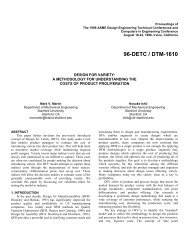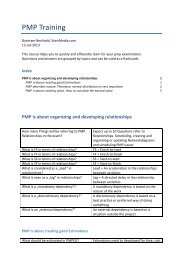Social Marketing
Create successful ePaper yourself
Turn your PDF publications into a flip-book with our unique Google optimized e-Paper software.
Execution<br />
The BEHAVE-based <strong>Marketing</strong> Plan<br />
Step 4: Define the marketing mix.<br />
Once you understand the benefits and barriers that matter to your audience it is time to construct<br />
your marketing mix. The decision about your product or services is always the first step.<br />
1. Product/Service: What can you create that will help your audience reduce barriers and<br />
increase benefits they care about.<br />
2. Price: What will putting that product or service in place cost ?<br />
3. Place: Where will you make that product or service available so that it is easily accessible?<br />
4. Promotion: how will you promote that product or service so that people believe its benefits<br />
are credible?<br />
For help in outlining the four Ps, see the <strong>Marketing</strong> Mix Decision Framework in the <strong>Social</strong><br />
<strong>Marketing</strong> Tools.<br />
Step 5: Prototyping and pre-testing.<br />
Once you have an idea, it needs to be tested. Prototyping is used to test new products and<br />
services. In short, marketers create a series of increasingly complex mock-ups and try them<br />
out with small groups of potential consumers who become full partners in the design process.<br />
Pre-testing is often used to test messages for comprehension, appeal and relevance.<br />
Step 6: Implement.<br />
Now, it’s time to carry out your plans. Using what you learned from pretesting, alter your marketing<br />
plan, and then begin carrying it out. One thing to remember: do not forget to consider<br />
how the campaign will be evaluated. Ensure that a plan is in place and ready to go before you<br />
implement the intervention.<br />
Step 7: Evaluate.<br />
You need to know whether your marketing plan is working. Perhaps parts of your plan are effective<br />
and others are not. An evaluation of the program should be designed before it is launched.<br />
And, make sure this evaluation relates back to the social benefit listed in Step 1 of the process.<br />
In the best campaign, certain parts of the evaluation are ongoing and can be measured regularly<br />
(daily, weekly, monthly, as often as possible), so the campaign can be tweaked as it moves<br />
forward.<br />
Step 8: Refine the campaign.<br />
Use the results of your evaluation to make changes in the campaign. Set aside a certain time<br />
to re-evaluate what you’re doing. Even if the results are good, nothing is perfect. You can make<br />
your campaign stronger. Before you launch the campaign, set the date for this re-evaluation,<br />
based on your evaluation schedule, so you don’t miss an opportunity to revisit a campaign and<br />
make it better.

















